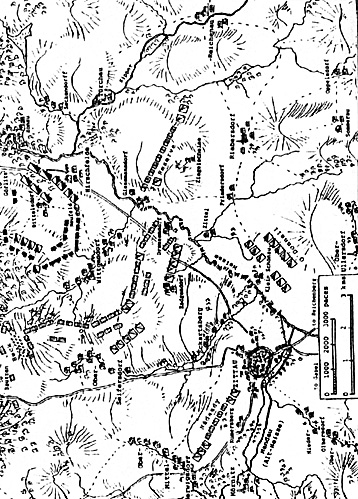INTRODUCTION
The waiting is over. The King of Prussia, needing to reach a decision in this theatre so that he can deal with the threat from the French, marches forward.
The confrontation that follows marks one of the great battles that never was. For four days, the rival forces, deployed within long cannon shot, glare at one another across a ravine. For a wargamer, this presents an excellent challenge. Can you see a way for either side to end the stalemate?
AUGUST 16th
At about 4 o'clock this morning, we received news that the Prussian movements of yesterday were nothing more than an attempt to mask the retreat of their army to Silesia. Events soon contradicted this report. An hour and a half after noon, several troops of Prussian cavalry appeared on the heights that dominate the village of Wittgendorf. We also learned that the whole of the Prussian army was marching towards us in several columns between Ostritz and Bernstadt: their left towards Hirschfelde, and their right to the wood. At that point, we fired the three cannon shots signifying "Alarm!" The whole Austrian army struck its tents and took up arms. His Royal Highness Prince Charles and Marshal Daun, together with all the volunteers of their suites, mounted their horses. We then marched the troops of the Left Wing forward into the line of battle. In this position: the right rested on a height which dominates the Neisse as far as the highroad from Zittau to Gorlitz; the left rested at the wood on the height above Seifersdorf. The Austrian line formed a kind of semi-circle overlooking and surrounding the village of Wittgendorf.
Since there was not enough infantry to occupy the ground completely, we marched there several regiments of cavalry; we inserted these into the infantry line in those regions most favourable for that arm.
The Reserve Corps set itself in battle array in a single line. The left rests on the village of Giessmannsdorf, where 4 bridges have been thrown across the Neisse. The right rests on a wood on a height. Behind is Friedersdorf; in front lies Turchau and the stream that runs through that village. Behind this position, there are a further 17 bridges across the Neisse between the front line and Zittau. The Reserve Corps comprises 15 battalions of infantry, 30 companies of grenadiers, and 15 squadrons of horse and dragoons.
The Corps of General Nádasdy was ordered to hold itself in readiness to march as required. Generals Beck and Draskowitz took their Croats forward into the woods and onto the heights in front of the high ground that the Austrians hold ground at Seifersdorf.
In this position we awaited the Prussians, ready to receive them from whatever side they came At 4 o'clock in the afternoon, the Prussians brought down some cannon, supported by infantry, onto the gentle slope that runs down to the village of Wittgendorf. Having formed four separate batteries, each firing from a different angle, they cannonaded the two companies of Austrian grenadiers who held the village. The grenadiers were finally obliged to abandon that part of the village lying on the far side of the ravine. That ravine extends from a large wood and the two heights between Wittgendorf and Seifersdorf, that the Austrians occupy, to Grosshennersdorff, of which the Prussians wish to become master. A short time later, the Austrians reinforced the grenadiers in Wittgendorf with four additional companies supported by cannon. These advanced in line and obliged the Prussians to withdraw from the part of the village that they had occupied. At this point, night supervened. The whole of the Austrian army rested in bivouacs; the Prussian army did the same.

More Journal of Horace St. Paul 1757
-
Part 1: Introduction (June 30-July 14)
Part 2: Introduction (July 15-July 25)
July 26, 1757
July 27, 1757
July 28, 1757
July 29, 1757
July 30, 1757
July 31, 1757
August 1, 1757
August 2, 1757
August 3, 1757
August 4, 1757
August 5, 1757
August 6, 1757
August 7, 1757
August 8, 1757
August 9, 1757
August 10, 1757
August 11, 1757
August 12, 1757
August 13, 1757
August 14, 1757
August 15, 1757
August 16, 1757
August 17, 1757
August 18, 1757
August 19, 1757
Back to Seven Years War Asso. Journal Vol. XI No. 4 Table of Contents
Back to Seven Years War Asso. Journal List of Issues
Back to Master Magazine List
© Copyright 2000 by James J. Mitchell
This article appears in MagWeb (Magazine Web) on the Internet World Wide Web.
Other military history articles and gaming articles are available at http://www.magweb.com